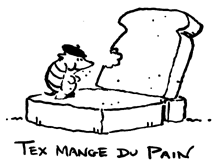Nouns
Introduction to Nouns
A noun is essentially a label for places, things, events, ideas, concepts and so on. Like English, nouns in French may be categorized as common or proper, count or mass, singular or plural. However, unlike English, French nouns are also categorized as either masculine or feminine.
common vs. proper
Common nouns in English and French are the generic term for something. Common nouns are never spelled with a capital letter unless they begin a sentence.
| un tatou | an armadillo |
Proper nouns are specific names and thus begin with capital letters.
| Tex et Tammy | Tex and Tammy |
count vs. mass
Another way of classifying nouns is according to whether they can be counted or not. Count nouns identify individual entities that can be counted, like armadillos.
| un tatou, deux tatous | one armadillo, two armadillos |
In contrast, a mass noun refers to an entity as an uncountable unit. In the following example, the bread that Tex is eating is conceived of as a mass, that is, an undefined quantity.

| Tex mange du pain. | Tex is eating bread. |
The difference between count and mass nouns is usually clearcut. However, something that is typically countable such as an animal (one armadillo, two armadillos, three armadillos) can nevertheless be conceived of in terms of a mass, as in the following tasteless example.
| Berk! Il y a du tatou écrasé partout sur les autoroutes du Texas. | Yuck! There’s squashed armadillo all over the Texas highways. |
singular vs. plural
All nouns in French and English are marked for number, that is, for singular (one) or plural (more than one). French, like English, usually indicates plurality by adding an -s to the end of the base form, the singular noun. Count nouns have both singular and plural forms:
| le tatou, les tatous | the armadillo, the armadillos |
Mass nouns typically have only a singular form. Try saying the plural forms of the following English mass nouns: sewage, mucus, plasma.
It sounds strange doesn’t it? This shows that it is difficult to pluralize a mass noun.
masculine vs. feminine
In English, grammatical gender is based on biology and is only relevant for pronouns (he, she, it) and possessive determiners (his, her, its). Gender in French, on the other hand, affects all nouns, pronouns, adjectives and articles. A noun’s gender is indicated by the article that precedes it. Masculine nouns are preceded by le and feminine nouns by la. The use of articles in French is more widespread than in English.
| le garçon | the boy |
| la fille | the girl |
Unlike English, the grammatical concept of gender in French has little to do with biological sex. Therefore, inanimate objects such as tables and desks are categorized as either masculine or feminine (there is no neuter gender in French grammar).
| la table (feminine) | the table |
| le bureau (masculine) | the desk |
Remember that gender in French, for the most part, is not about sex, but is simply an arbitrary category. The terms ‘masculine’ and ‘feminine’ really mean nothing more than ‘noun class A’ and ‘noun class B’. Because grammatical gender is fairly arbitrary, it is essential to memorize a noun’s gender along with its spelling and pronunciation.

